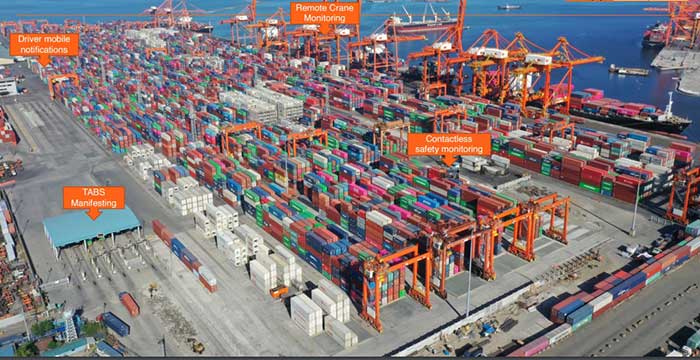Manila International Container Terminal (MICT), the flagship port of International Container Terminal Services Inc. , is rolling out technology-driven solutions that will cut the foot traffic within the area.
“The strategy for MICT has been to really try to leverage technology and remove the need for anyone to still go to the terminal. And in case people would still need to go, (we will) try to eliminate the face-to- face transactions… and try to make their stay as short as possible so they can either work and have less exposure and go back to their homes,” said Reynaldo Mark Cruz Jr., Information Technology System and Services director at MICT at a forum hosted by the German-Philippine Chamber of Commerce of the Philippines on Tuesday.
Long before the pandemic back in 2017, MICT launched a online payment portal but the user adoption was very low, at around 30 percent.
According to Cruz, the billing area had the largest foot traffic in MICT despite the availability of an online system.
Cruz said with its online portal, MICT enables brokers and customers to witness the examination of containers remotely without the need to go to the terminal.
But Cruz said MICT needs to get the go- signal from the Department of Agriculture for the use of the portal in witnessing examination of farm goods.
For trucks and the truck drivers who really need to come to the terminal, Cruz said MICT has the automated gate system that makes use of the Optical Character Recognition (OCR) and the License Plate Recognition (LPR) technology that capture images and automatically read the container number and the plate number of the truck to facilitate entry.
RFID sensors are also installed all around the port to help identify the trucks that are coming in.
Late last year, MICT established a strategic partnership with Smart to equip the entire terminal with the 5g network coverage.
“This is really looking at the future and setting up the stage for all the other future IoT devices that will come out. We are looking at remote drone inspection, reefer monitoring, even goggles for engineers and all those things,” Cruz said.
One of the initiatives implemented was the installation of 5G sensors in all of MICT’s rubber train gantries and the use of the remote weighing systems.
Cruz unveiled future innovations in MICT to further cut footprint in the port.
One of these is TABS Manifesting which would capture container data and plate number during booking under its automated gates systems. This would eliminate the need for the drivers to input anything at the kiosks upon arrival.
The other is Driver Messaging which would eliminate congregation of drivers around the Bureau of Customs X-Ray office to wait for results.
Cruz said a new MICT app will be rolled out later this year with added features such as GPS.
By making use of the GPS functionality of the devices, the terminal will be able to at least estimate if the arrival of the truck will be delayed, thus enabling the driver to adjust the booking to avoid penalties.
Cruz said MICT will take advantage of the GPS towards an eventual gate less inbound setup for MICT through the use geo fencing for gating in trucks.
“Because we already see the location of the truck. We know the container that is handling.
So whenever he processes geo fence into the MICT terminal we already know you’re here don’t need to register in the kiosk and over the app. We will also just send the location of the container here to pick up. And actually after that we’re also looking at pushing it even further by taking advantage of GPS capability of mobile phones,” Cruz said.
In reaction to feedback of drivers getting lost inside MICT, Cruz said they plan to install a Waze-like setup for drivers for picking up or dropping off containers in the terminal. Irma Isip




